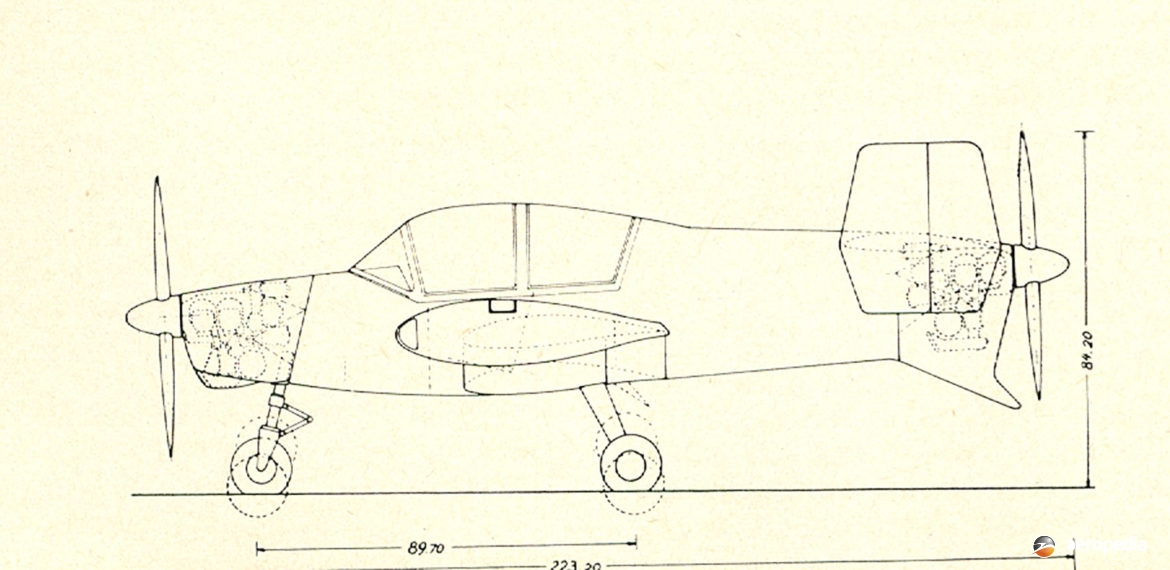Photograph:
An artists drawing of the KY-02 Libellula aircraft (Author’s collection)
Country of origin:
Australia
Description:
Four-seat light amateur-built monoplane
Power Plant:
Two 64 kw (86 hp) Sportavia Limbach SL2100D four-cylinder, four-stroke, horizontally-opposed air-cooled engines
Specifications:
- Wingspan [front]: 9.75 m (32 ft)
- Wingspan [rear]: 6.10 m (20 ft)
- Length overall: 6.67 m (21 ft 10¾ in)
- Height: 2.68 m (8 ft 9½ in)
- Wing area: 11.90 m² (128 sq ft)
- Max speed (Estimated performance): 341 km/h (212 mph)
- Max cruising speed: 272 km/h (169 mph)
- Stalling speed: 67 km/h (41 mph)
- Max rate of climb at sea level on one engine: 113 m/min (372 ft/min)
- Range with max fuel: 1,610 km (1,000 miles)
- Fuel capacity: 136.5 litres (36 Imp gals)
- Empty weight: 552 kg (1,217 lb)
History:
The Libellula was designed by Mr Yager of Lewisham, NSW, being a light twin-engine touring aircraft for amateur construction with plans to be made available to builders. The design was derived from the Mignet Pou de Ciel series as an aircraft that could not stall, Mr Yager stating in 1968 that he had met the late Henry Mignet and was allowed to fly one of his HM-14 aircraft, despite the fact that he only had a glider pilot’s licence. It seems he chose a twin-engine aircraft due to restrictions by the Department of Civil Aviation that no single-engined aircraft was allowed to cross the Tasman Sea and all twin-engined aircraft on the market were in a price range only a few could afford. He also at the time referred to a number of twin-engined aircraft which appeared after World War II. He learned to fly in 1930.
It seems the design went through three variants before work commenced on the construction of a prototype. The second design was to be of spruce and ply with birch plywood construction, powered by either the Continental A65-12 engine or the converted Volkswagen, both being four-cylinder horizontally-opposed units. This aircraft seated two, was aimed at the market as a sporting aircraft which could be used for training, and which could eventually be built for agricultural work.
The front and rear wing were detachable with a carry-through spar, both being of what was described as geodetic construction. It had a tricycle undercarriage and had an estimated empty weight of 401 kg (885 lb) and a loaded weight of 680 kg (1,500 lb). However, there was a problem in that the ANO only permitted an all-up weight of 680 kg (1,500 lb) for homebuilt aeroplanes and the aircraft would not fit easily into that ANO. It was calculated to have a maximum speed of 312 km/h (194 mph), a cruising speed of 254 km/h (158 mph) and a landing speed of 48 km/h (30 mph).
Continuing development of the design lead to the KY-03. It is known two KY-03 aircraft were under construction from 1974, one by Mr Yager and another by Mr Colin Herbert in Adelaide, SA. However, photographs of the aircraft have not yet come to light. This, the ultimate design of the Libellula, seated four, had cantilever tandem wings of 2024 light alloy two-spar construction with PVC foam sandwiched between and bonded outer skins. The front wings had a five degrees dihedral and an incidence of -1º12”. The ailerons and plain trailing-edge flaps were on the front wings, and the elevators on the rear wings. The fuselage was of semi-monocoque structure of 2024 light alloy with light alloy/PVC foam sandwich skin in the cabin area. The tail unit had swept back fins and rudders mounted at approximately one quarter span on the rear wings.
The tricycle undercarriage was retractable, with manual retraction of all units into the fuselage, the main units inward and the nose unit rearward. Oleo shock-absorbers of Yager design were fitted. It was decided the power plants were to be Sportavia Limbach SL2100D four-cylinder, four-stroke, engines, each rated at 64 kw (86 hp), one in the nose and one in the tail, each driving a Hoffman V.62 two-blade variable-pitch propeller. A fuel tank was located in each front wing with a total capacity of 136.5 litres (36 Imp gal). Accommodation was provided for four persons in side-by-side seating in pairs, and access was via an upward-opening framed canopy.
The prototype was completed. Reports indicate it carried out taxiing trials and short hops but it seems there were short-comings in the design and production did not go ahead. The aircraft has not appeared on the Civil Aircraft Register and its fate is not known.

